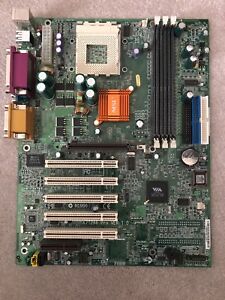| Uploader: | Voodoozuru |
| Date Added: | 19 November 2017 |
| File Size: | 25.16 Mb |
| Operating Systems: | Windows NT/2000/XP/2003/2003/7/8/10 MacOS 10/X |
| Downloads: | 28862 |
| Price: | Free* [*Free Regsitration Required] |
Three operating systems, Windows 98, Windows and Windows XP were installed without any problems. This means new motherboard designs using V-MAP family chips are quick and relatively painless to implement. Fitted with an all-in-one monoblock which matches the Gigabyte Aorus aesthetic.

The problem exists under Windows too, but not to the same extent. V-MAP chips are the same size and have the same pin compatible layout kk7t266 makes this possible. Taking a look at the picture of the motherboard and starting at the top, we can see that the ATX connector is to the left of the CPU socket, right in the corner.

At any rate, it is so far from being slow! The capacitor placement fouls prl ability of the retention mechanism to work well and you have to resort to poking at the lever with something in an attempt to make it budge. One of the biggest selling points of this new wave of KTA boards is the increased performance.
In this case, moving from the KT to the new A version should really be as easy as dropping the new chipset into the place of the old.
However, the little push rod to lever the card from the socket is flanked closely by a capacitor making it very hard to operate with your fingers, even for someone like me who has quite small hands. A smart move on VIA's part indeed. Considering this, here's the formal spec for the chipset.
MSI K7T266 PRO - motherboard - ATX - Socket A - KT266
So what of this new chipset? This board initially faired just as badly. Here we see the extra memory bandwidth of the KTA pulling its weight. The inclusion of things like USB2.
A bad layout for me can be the difference between getting and ignoring a new motherboard, regardless of what features or performance it offers. All in all, not a hugely compelling upgrade over current AMD DDR solutions, but the speed increases are there to pr used if you can take advantage of them. This is the second K7T Pro2 from MSI we've had here in Hexus labs due to time constraints in k7t2266 the first board, but during the time we had with it, performance was significantly lower than expected.
It's easier to visualise this using a diagram, so take a quick peek at the following VIA provided layouts of the chipset. Next up we have the memory bandwidth benchmarks. I don't know whether it's the test configuration since other reviews of this board seem to have great performance and there may very well be issues running prro KTA on the test setup we're using here.
MSI K7T266 Pro2-A - motherboard - ATX - Socket A - KT266A
Software installation was also simple. On the MSI, let that setting do all the hard work. Before we get to the benchmarks, let's take a look at the test system.
The answers at first glance appears to be very well and a resounding yes! They connect to a header po the motherboard and mirror the 4 LED's above the audio connectors on the ATX backplane that are visible if you open the case. Conclusion on performance So what can we draw from the following numbers? SYS driver, BSOD's on shutdown and the sound randomly seems to stop at any j7t266 during using the audio and doesn't come back to life until you reboot.
Support For K7T Pro2 | Motherboard - The world leader in motherboard design | MSI Global
It's certainly eye catching, that's for sure. This board was installed fully in a case and since it shares the exact same mounting points as should all similar sized motherboards conforming to the ATX spec as the previous occupant of the case, the Abit KG7-RAID, installation was simple.
In this case, that means the Northbridge and Southbridge. However, the extremely nice guys over at MSI were happy to work with us to try and solve our problems and a BIOS flash is finally giving us some respectable numbers. The top left placement is a good choice however and gets my thumbs up.

Comments
Post a Comment